Embark on a journey through Barcelona's captivating art and architecture. Explore the visionary works of Gaudí, Picasso, and more, set against the city's stunning landscapes.
GVI
Posted: July 5, 2024

Posted: October 16, 2018
A little blog about Buddhism and art in Cambodia
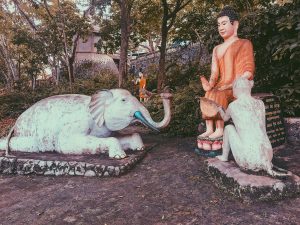
With no background in art I arrived in Cambodia and was instantly stunned by the beautiful statues that can be found all across the country. Over a month in, I’ve now done a little research about the different statues of Buddha that can be found here, ranging from miniature statues on teachers’ desks, to goliath golden plinths that have regularly left me gaping. Hopefully this blog will serve two purposes: showcasing the beautiful world that is Kampong Cham and helping form a picture of what life in Kampong Cham is like; and giving a small insight into why so many different versions of Buddha statues exist in Cambodia. Enjoy!
Buddhism in Cambodia 101
Theravada Buddhism, the oldest form of Buddhism still followed today, has its origins in Sri Lanka, and today forms the major religion of Cambodia, Laos and Thailand. With a tendency to be quite conservative, followers of Theravada Buddhism tend to adhere to the teachings of the Dhamma (Buddha) closely. As expected, the Buddha plays a very central role in Theravada Buddhism and as such, much of the art and statues here in Cambodia are depictions of the religion’s central figure.
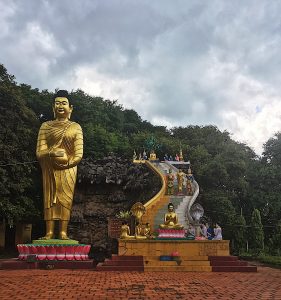
Buddhist teachings tell us that Buddha, also known as Siddhartha Guatama or Shakyamuni was born in the 5th Century BCE. Born a prince, the Buddha came to denounce his wealth and privilege, continuing his life in search of meaning. The scripture follows and culminates in the Buddha reaching Enlightenment whilst meditating under a Bodhi tree, and eventually passing from this realm into the final and permanent stage of reincarnation – nirvana. In fact, ‘Buddha’ is not a name but actually a title, meaning “enlightened one”. In Cambodia, Theravada Buddhism is the most followed religion, with roughly 97% of the country following the teachings of the Dhamma (Buddha). As such Buddhism has helped form, and plays an essential role in, all aspects of Cambodian public life, influencing schools, economics, sports, and art.
Reclining Buddha
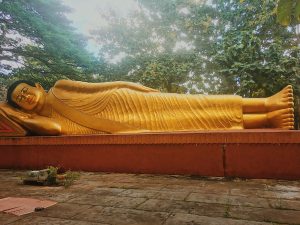
One of the most awe-inspiring statues at the Pagoda our volunteers teach at is a 40-meter-long ‘Reclining Buddha’ statue. A common statue that is found across pagodas in Cambodia, the ‘Reclining Buddha’ symbolises the final illness of the Buddha, before it is told he passed onto parinirvana (Nirvana-after-death). Although interpretations of this statue have some small differences, they all show the Buddha lying on his side, with his head resting on his head – demonstrating the peacefulness of the Buddha’s final illness. The ‘Reclining Buddha’ statue at the pagoda where our volunteer’s teach local monks English, like the similar statues up and down the country, is an incredible site. Based on size alone, these colossal statues illuminate the quintessential role Buddhism plays in Cambodia.
The Buddha’s large ear lobes
One common aspect of the Buddha’s appearance in many different interpretations is his large ear lobes, a characteristic which has its origins in the story of the Buddha’s life. Having been born into royalty and having all the wealth afforded to such a position, the Buddha renounced his earthly possessions. Much like the Middle-aged punk rocker that now finds themself in an office job, the Buddha removed his large golden plugs and so spent the rest of his life with stretched earlobes.
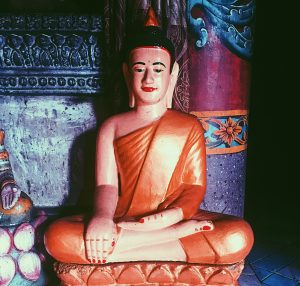
This subheading is to tell you the blog over
Well that’s it for now! I hope you’ve enjoyed my slightly denser blog post and hopefully I’ll do another one soon. Here in Cambodia there’s a lot to see and a lot to learn. If you’re looking to undertake some voluntary work where you teach and learn in equal measure get in touch!
A little bonus section for nerds like me: Budai – ‘Laughing Buddha’
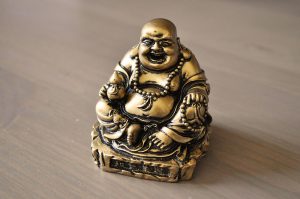
I know this section is less relevant to Cambodia but I wanted to include it anyway so here it is as an ‘optional extra’. Back in the UK, the visual exposure to the Buddha I experienced was a mixture of small statues of ‘Laughing Buddha’ and other interpretations used in mass production – t-shirts, posters, and keychains.
‘Laughing Buddha’, known as Budai, Hotei or Pu-Tai, was a semi-historical monk who lived in 10th Century China who introduced into the Zen Buddhist tradition. With importance in the tradition followed in China, Japan and Vietnam, Budai was supposedly jolly, humorous and eccentric, garnering the nickname ‘laughing Buddha’.
As such, Budai is often depicted laughing, and large in size – a visual representation of his ‘larger-than-life’ personality. What is often misunderstood however, is that ‘laughing Buddha’ is not a depiction of the central figure – Buddha – but Budai, who it is stated lived roughly 1500 years later!
Embark on a journey through Barcelona's captivating art and architecture. Explore the visionary works of Gaudí, Picasso, and more, set against the city's stunning landscapes.
GVI
Posted: July 5, 2024